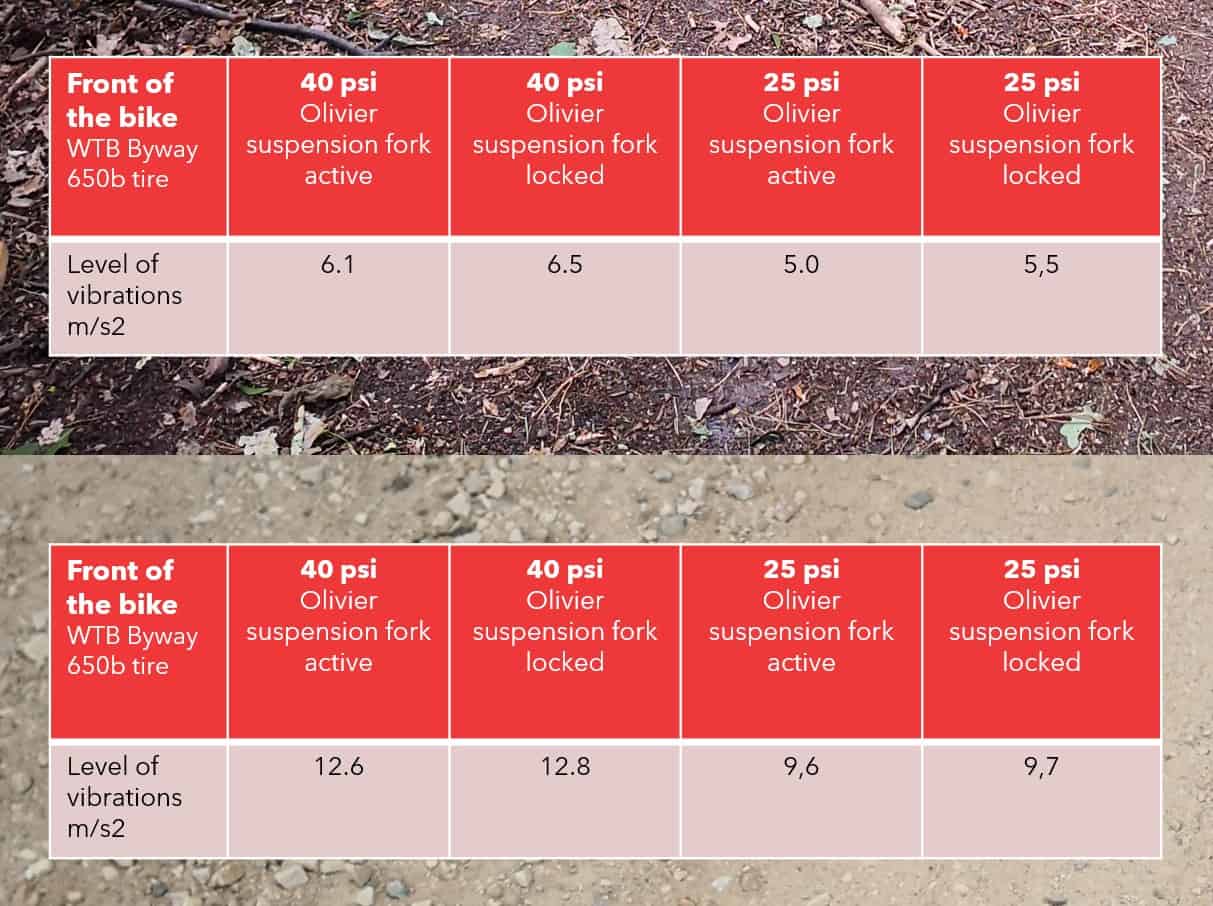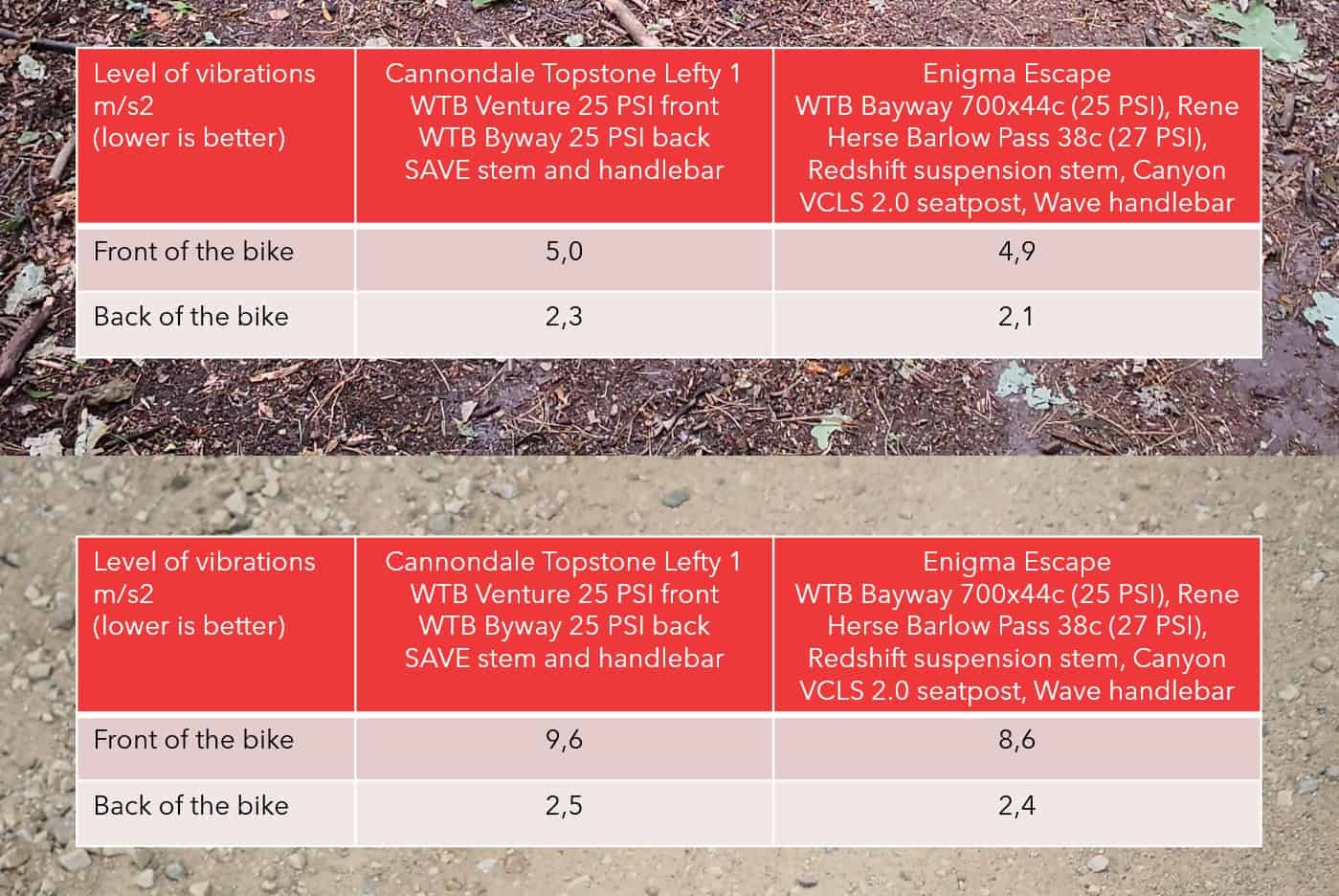Table of Contents
I’ve been waiting for this moment for a very long time. I finally got the opportunity to test a gravel bike with a front suspension fork with a proper damping system.
Meet the top-of-the-line Cannondale Topstone Carbon Lefty 1 with the Oliver gravel suspension fork.
I had a hell of a ride on it! But does this fork deliver a magic carpet ride?
Keep on reading to find out…
The Cannondale Topstone Carbon Lefty
I recently tested the Cannondale Topstone Carbon gravel bike with 700C x 38mm tires and a rigid fork. I really liked the overall vibration damping of the bike and especially the comfort balance between the front and rear.
The front comfort was so good on the rigid model thanks to the SAVE flex handlebar that I was even questioning whether the bike needed front suspension at all.
Well, I’ve now had the chance to find out because Cannondale sent me their Topstone Lefty 1 with Oliver suspension fork so I can take some vibration measurements. On paper at least, this should be the best comfort package you can find on any gravel bike.
A Big Change
The Topstone Rigid bike that I tested recently was a well-rounded, comfortable, fast, and rather normal bike to ride in terms of handling.
But I didn’t find it to be particularly playful and definitely not encouraging you to become a gravel hooligan.
This Cannondale Topstone Carbon Lefty, however, is a proper hooligan thanks to its 650B wheels and suspension fork. These component changes have essentially transformed the Topstone from a sensible, all-around choice to a machine that will take on the roughest gravel roads and trails.
The handling feels quicker, the rear becomes more alive, and overall, you unlock more fun while riding on this bike.
The 650B tires are not only good for improving the fun factor of the Topstone, but they also improve the overall comfort and traction because you can employ lower tire pressures.
Cannondale could’ve stopped there, but they’ve added a dedicated gravel suspension fork to the bike. And this decision is very tricky to evaluate.
Yes, the suspension fork offers a forgiving ride, but at the same time, it adds weight (around 1kg/2.2lb), cost, and requires maintenance if you want it to work flawlessly for years to come.
When you consider all of those downsides, you should have very high expectations of the performance of the Lefty – otherwise, why bother?
The Role of Suspension Forks
Suspension makes the ride more comfortable because it can suspend you from road imperfections.
But the biggest benefit of having a suspension fork is actually the improved front tire traction. Without a suspension fork, your front wheel bounces a lot when hitting bigger obstacles, and as a result, your tires have less opportunity to grip the ground, and your bike becomes less stable overall.
With a suspension fork, you can also ride faster and longer on rough terrain without feeling beaten up.
Honestly, when I got this bike I was not thinking about traction or bike stability. My focus was strictly on reducing the vibrations that are reaching my body. Yet, just a couple of rides on the Topstone Lefty and I can clearly see the benefits of improved front traction.
The combination of the wide 650B tires and Lefty Oliver fork (even with only 30mm travel) made me ride this bike a true hooligan way. No matter the road, I was trying to ride as fast as possible, and most of the time I was well beyond the speeds that I would normally ride.
And the harsher the road, the more the Topstone Lefty shone.
Topstone Lefty vs Topstone Rigid
The Topstone Lefty excels in the rough stuff and otherwise is just ok everywhere else. You feel it, especially when riding on the tarmac where both the 650B wheels and the added weight of the suspension fork reduce the fun. Of course, it’s still quite fast on the tarmac but it’s not the scenario the bike was made for.
The Topstone Rigid on the other hand is very good in almost every gravel situation. While you cannot ride it as hard, it has a better balance between off-road and on-road rides.
And what about the comfort benefits, you may ask? Is a suspension fork worth the extra hassle?
Look, I embrace any comfort-improving bike parts, and a suspension fork seems like the ultimate solution in that regard. But in reality, after testing the Lauf Grit SL suspension fork and now the Lefty Oliver fork, I am not sure we need a suspension fork for ride comfort.
Bike Setup For The Vibration Test
The Lefty Oliver has a proper suspension damper so, unlike the Lauf Grit SL, it rides without any bounciness. But even with proper damping, the comfort-improving effect feels modest at best.
I first tested the fork with my tires at 40 psi. This is significantly more pressure than I’d normally use but the tires play such a big role in bike comfort, so running them at high pressure allowed me to see what comfort the Lefty Oliver was really offering.
I then tested the Topstone Lefty against my titanium benchmark bike with 25 psi in the tires.
My benchmark bike was using an Open U-Turn fork, Redshift ShockStop stem, Coefficient Wave handlebar, WTB Byway 700C x 44mm front tire, Rene Herse Barlow Pass 700C x 38mm rear tire, and Ergon Allroad Pro carbon seatpost.
Vibration Test Results
You can see my vibration measurement procedure & outdoor test courses HERE.
Interestingly, it seems the tire pressure is what’s doing all the heavy lifting in terms of vibration damping!
On the bumpy forest trail, the vibrations at the handlebars were 15 to 18% lower with 25 psi in the tires. Meanwhile, when the fork was active, the vibrations were reduced by just 6 to 9% compared to when it was locked out.
And on the fast gravel road, the vibration differences were starker. The lower 25 psi tire pressure resulted in 24% fewer vibrations compared to 40 psi. And the active fork was attenuating only 1 to 1.5% more vibrations than when it was locked out!
Clearly, the Lefty is not able to adequately deal with the high-speed buzz of fast gravel roads.
When I compared the Topstone Lefty to my benchmark bike, it was even a bit less comfortable.
On the bumpy forest trail, the front end was in the same ballpark (2% more vibrations). But when it came to the fast gravel road, the Lefty Oliver suspension fork was transmitting 10% more vibrations to my hands compared to my benchmark bike.
This is not at all a failure for the Lefty fork. The Topstone is still an unbelievably comfortable ride! But it’s just not as effective at providing vibration-damping as the combination between my Open U-Turn carbon fork and Redshift ShockStop suspension stem.
Summary
Out of the box, the Cannondale Topstone Carbon Lefty is a very, very comfortable bike. According to the vibration data, it’s very close to my benchmark bike in terms of comfort. That’s pretty amazing considering how much effort I’ve put into optimising the comfort of my bike (tires, fork, bar, tape, stem, seatpost, saddle & more).
But remember that the Topstone Lefty is a one-trick pony: it’s incredible when the gravel roads are rough and technical. It makes you want to ride it hard and be a hooligan. But it’s not an all-rounder that suits every road type – the Topstone Rigid bike with 700C wheels does that better.
If your use case is specifically rough and technical gravel roads, this bike will be awesome. Alternatively, you could make this your second gravel bike – the gravel hooligan – for the sheer enjoyment it offers.
The other big question is should you buy the Lefty fork for your current gravel bike?
If you’re buying it for additional comfort, it’s not worth it. You can achieve similar levels of comfort via other means. But if you want to significantly improve your front traction and bike stability on rough gravel tracks, and you’re happy with the €1600 purchase price, then go for it.














